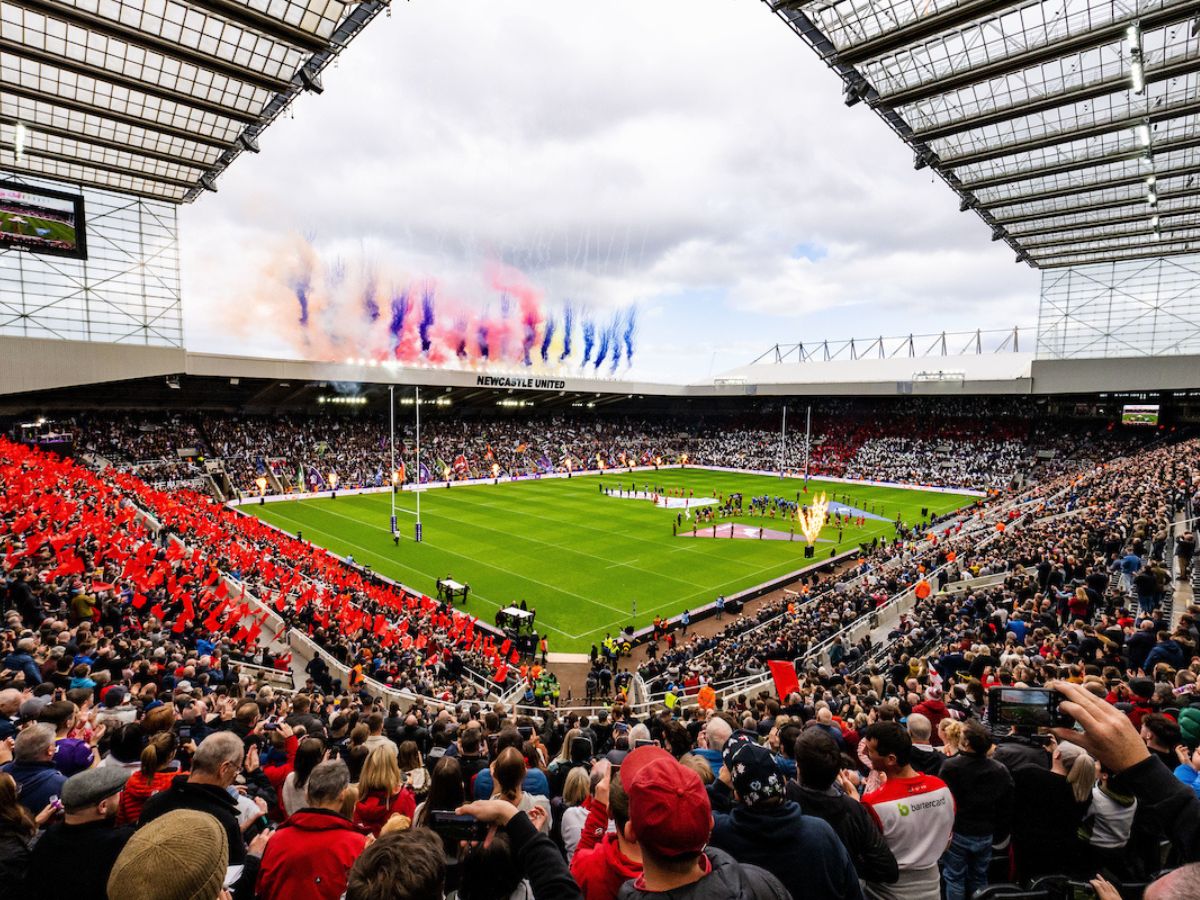© The Fan Experience Company 2023

‘It’s a perfect storm’: How the cost-of-living crisis is hitting the UK live events business
You never know what you’ve got until it’s gone.
That was the prevailing sentiment during the pandemic, when the onset of Covid-19 forced the live events industry to shut down for the best part of two years. Live sport has since returned, as have fans and full stadiums, but while the sight of packed stands has come to signify a return to normality, event organisers are now being confronted by a new set of challenges.
In recent months, sports teams, venue operators and their suppliers have been adapting to a series of macroeconomic headwinds that are stretching budgets and sending costs through the roof. In the UK specifically, inflation has leapt to 10.4 per cent, with increases in food and beverage costs contributing towards that rate reaching a 40-year high. Against the backdrop of the war in Ukraine, too, spiralling gas and electricity bills have further squeezed consumer spending power and forced the UK government to implement an energy price cap.
Those factors are impacting the public on an individual level, but they are also affecting the business of live events. After all, opening large venues for mass gatherings costs money, requiring armies of staff, vast supplies of snacks and drinks, and a multitude of other infrastructure and amenities needed to host thousands of people.
Footing the bill
It is understood that some venues in the UK have seen a seven-figure annual increase in their energy bills. One Premier League club told SportsPro that operating costs have increased by 21 per cent year-over-year, with food and beverage procurement up 24 per cent in that time. In September, a survey published by Fair Game found that 63 per cent of lower-league English clubs would consider earlier kick-off times to save on floodlight costs.
What’s clear is that the cost-of-living crisis is impacting businesses throughout the entire supply chain.
“I think every business, venues in particular, are facing rising costs in a world where you’re entering into a recessionary environment where people have got less disposable income,” says Martin Jennings, the head of global planning at experiential agency Legends International, which works with the likes of Real Madrid and Liverpool on maximising the use of their venues.
“Also revenues – certainly in terms of ticket sales for events or venue hire fees – are not increasing at the same rates as costs are increasing, so it almost feels like you’re heading into a perfect storm in terms of increasing costs and static revenues.
“That means people are having to be creative in terms of what they then do to try and fill the gaps which are then left in the plans they put together, and also to make sure they still have a viable business or venue going forwards.”
Jennings says one way for sports organisations to mitigate rising costs is to sweat their assets. That could mean attracting other events outside of gamedays or creating food and beverage offers and other supplementary experiences that incentivise supporters to spend more time – and therefore money – at the venue.
London’s O2 Arena, which is operated by AEG and hosts more than 200 live events each year, has implemented measures of its own, including introducing an “energy charge” for promoters who hire the venue for their events. As part of its wider sustainability efforts, The O2 has also appointed an energy manager to be responsible for lowering the facility’s energy consumption, which ultimately reduces costs and cuts emissions.
“It’s definitely a huge impact,” says Adam Pearson, the commercial director at The O2, which recently hosted the Ultimate Fighting Championship (UFC) for a tenth time. “I think our reflection on it is all of those macroeconomic factors that impact our ability to be profitable are completely outside of our control. So our approach is less about trying to mitigate, it’s as much about top-line growth and doing all the right things to maximise event attendance and maximise spend on site.
“We had to implement an energy charge at the peak of that crisis. It wasn’t about passing through absolutely everything. It was about sharing in that pain. That doesn’t directly impact our ability to host, but it does impact all of the stakeholders that are involved in putting on an event. Because fundamentally, costs are rising.”
The people problem
Controlling costs whilst finding enough staff to run events remains a challenge in many countries and the UK is no exception. The hospitality sector is one of the biggest recruiters in the country but it also has the highest volume of variable staff of any industry, making the job of training and retaining skilled workers all the more challenging.
At the end of 2021, according to a survey commissioned by the UK’s Department for Digital, Culture, Media and Sport (DCMS), 96 per cent of outdoor event organisers were experiencing problems with staff shortages. These shortages were found to have had a fundamental impact on the productivity of the industry, with 72 per cent of survey respondents having been forced to turn away business. To make matters worse, increased wages were becoming a growing concern for organisers, with more than half reporting that staff costs had risen by ten per cent or more.
Recruiting and retaining talent has been a particular challenge for Arena Group, a major supplier of temporary structures, seating and other equipment to event operators around the world. Its event slate for 2023 includes the Cheltenham Festival, golf’s Ryder Cup and the Queen’s tennis tournament in London – all major gatherings built on legions of agency staff and no small amount of temporary infrastructure.
“The biggest challenge that we’ve got is actually finding the people who are willing to do the hours and who have the passion for it,” says Tom Evans, the company’s chief executive for the UK and Europe. “We’re competing with some of the Amazon warehouses, for example – they’re offering some amazing packages and air conditioned warehouses. Staffing, on the ground level, is probably our biggest challenge.”
Evans is not the only one to cite competition from Amazon as an obstacle to attracting and retaining staff in the events and hospitality sector. Others in the industry have seen something of an exodus take place as much of the workforce, particularly agency staff, seeks greater security and certainty around things like pay and working conditions.
For Pearson, however, the tide is beginning to turn.
“I think the hospitality industry is starting to do a good job of reminding people of why it is good to work in the industry, why it is fun, why it does have benefits,” he says. “When you think of what young people and what the next generation want, it’s flexible working, but it’s also variety. They don’t want to just clock in and clock out nine to five, Monday to Friday. So the ability to do two shifts one week and 14 shifts the next because you need it or you want it, or that’s just what your life dictates, then hospitality is great for that.”
A sustained recruitment drive, coupled with higher rates of pay and additional incentives, has helped to fill vacancies since the easing of pandemic restrictions. Technological solutions, such as mobile ticketing, cashless concessions and digital apps for staff training purposes, have also been deployed to help make up the workforce shortfall. Meanwhile innovations like data-driven fan behaviour modelling are enabling organisers to better understand consumption patterns and therefore plan their staffing and logistical requirements more precisely.
Some operators, including The O2 and the aforementioned Premier League club, are employing a more sophisticated, dynamic approach to staffing based on data insights related to venue use. At many large stadiums and arenas, the start and finish times of staff shifts are now staggered to mirror attendee arrivals and departures, with resource assigned and reallocated to specific areas at certain times to streamline operations and keep costs down.
“We’ve got some brilliant technology that forecasts on an event-by-event basis what we expect to sell and what that sales curvature looks like,” says Pearson. “It’s a model that improves the more it’s used.”
Resourcing appropriately is good practice for every venue operator and event organiser, of course, but sometimes it is impossible to account for wider factors outside of their control.
In the UK, post-Brexit immigration policies and employment rules have served to exacerbate staff shortages, opening up a skills gap, driving up costs and leading to restrictions in venue capacity and trading hours for businesses in many sectors, not least service industries like hospitality.
Specialist areas such as catering, security and front-of-house management have long been reliant on labour from European Union (EU) countries. Prior to the pandemic, 24 per cent of hospitality workers in the UK were from overseas. According to the Office of National Statistics (ONS), almost 100,000 EU nationals had left accommodation and food services in the two-year period up until June 2021, the highest of any industry.
Since the UK formally left the EU bloc and free movement of people ended in January 2021, calls have repeatedly been made on the UK government to create special limited-term visas specifically for workers in the hospitality sector. To date, however, such permits have only been offered to those who qualify for a skilled work visa, which comes with a minimum salary threshold of UK£25,600 and requires workers to secure a full-time position.
“Historically, we had a labour force who could easily travel between geographies and now that support labour isn’t there anymore,” laments Evans. “That’s increased prices, and we don’t have the flexibility of bringing in so much agency labour during the peak season. Brexit has been a negative for us.”
Original article published 31.03.2023 on the www.sportspromedia website (written by Sam Carp and Michael Long.
To view the full article, click here
